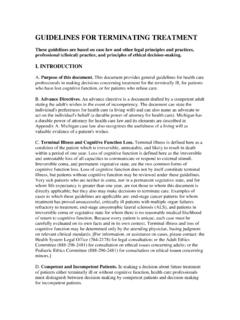Transcription of A CDC FRAMEWORK FOR PREVENTING INFECTIOUS DISEASES
1 A CDC FRAMEWORK FOR PREVENTING INFECTIOUS DISEASES sustaining the Essentials and Innovating for the Future OCTOBER 2011 CENTERS FOR DISEASE CONTROL AND PREVENTION Thomas R. Frieden, , , Director Rima F. Khabbaz, , Deputy Director for INFECTIOUS DISEASES OFFICE OF INFECTIOUS DISEASES Rima F. Khabbaz, , Director INFLUENZA COORDINATION UNIT Stephen C. Redd, (Rear Admiral, USPHS), Director NATIONAL CENTER FOR EMERGING AND ZOONOTIC INFECTIOUS DISEASES Beth P. Bell, , , Director NATIONAL CENTER FOR HIV/AIDS, VIRAL HEPATITIS, STD, AND TB PREVENTION Kevin Fenton, , , Director NATIONAL CENTER FOR IMMUNIZATION AND RESPIRATORY DISEASES Anne Schuchat, (Rear Admiral, USPHS), Director CENTER FOR GLOBAL HEALTH Kevin M. De Cock, , , Director Cover (clockwise from left): Salmonella sp. bacteria, HIV virions, and avian influenza A (H5N1) virions Images on cover and on page 10 courtesy of CDC Public Health Image Library; image on page 25 courtesy of Margaret Ransbotham.
2 A CDC FRAMEWORK FOR PREVENTING INFECTIOUS DISEASES sustaining the Essentials and Innovating for the Future OCTOBER 2011 Atlanta, Georgia CONTENTS Executive Summary .. iii Introduction ..1 Elements and Priorities ..8 Element 1. Strengthen public health fundamentals, including INFECTIOUS disease surveillance, laboratory detection, and epidemiologic investigation ..8 Element 2. Identify and implement high-impact public health interventions to reduce INFECTIOUS DISEASES ..14 Element 3. Develop and advance policies to prevent, detect, and control INFECTIOUS DISEASES ..20 Conclusion ..25 References ..26 Boxes Box 1. Examples of INFECTIOUS disease threats, unusual health events, and newly discovered pathogens, worldwide, 2000-2011 ..2 Box 2.
3 Linkages between chronic and INFECTIOUS Box 3. INFECTIOUS disease issues of special concern ..6 (Also listed in Box , page 16) ii | CDC ID FRAMEWORK EXECUTIVE SUMMARY INFECTIOUS DISEASES are a leading cause of illness and death throughout the world. The enormous diversity of microbes combined with their ability to evolve and adapt to changing populations, environments, practices, and technologies creates ongoing threats to health and continually challenges our efforts to prevent and control INFECTIOUS DISEASES . A CDC FRAMEWORK for PREVENTING INFECTIOUS DISEASES : sustaining the Essentials and Innovating for the Future CDC s ID FRAMEWORK was developed to provide a roadmap for improving our ability to prevent known INFECTIOUS DISEASES and to recognize and control rare, highly dangerous, and newly emerging threats, through a strengthened, adaptable, and multi purpose public health system.
4 Although its primary purpose is to guide CDC s INFECTIOUS disease activities, the document is also designed to guide collective public health action at a time of resource constraints and difficult decisions, while advancing opportunities to improve the nation s health through new ideas, partnerships, technical innovations, validated tools, and evidence based policies. The ID FRAMEWORK outlines three critical elements in these efforts: strong public health fundamentals, including INFECTIOUS disease surveillance, laboratory detection, and epidemiologic investigation; high impact interventions; and sound health policies. The document also describes priority activities for achieving these essential components of public health, highlighting opportunities afforded through scientific and technological innovations, new partnerships, and the changing public health and healthcare systems.
5 Element 1. Strengthen public health fundamentals, including INFECTIOUS disease surveillance, laboratory detection, and epidemiologic investigation Strong public health fundamentals at the local, state, and national levels including disease surveillance, laboratory detection, and epidemiologic investigation are the bedrock of capacity to protect the public from INFECTIOUS DISEASES and to save lives during outbreaks and other unusual health events. These three core activities create and sustain a flexible, multi purpose public health system that reduces endemic DISEASES and is ready and able to respond to new threats. Priorities of Element 1 include working with public health and healthcare partners to sustain and strengthen public health expertise and practice and to advance workforce development and training, ensuring that core capacities are not eroded.
6 Modernize INFECTIOUS disease surveillance to drive public health action Expand the role of public health and clinical laboratories in disease control and prevention Advance workforce development and training to sustain and strengthen public health practice Element 2. Identify and implement high-impact public health interventions to reduce INFECTIOUS DISEASES Focused efforts to prevent and control high burden INFECTIOUS DISEASES can achieve dramatic results within a short time frame, reducing disease burden and health inequities while saving lives and dollars. Priorities of Element 2 include identifying and validating new tools for disease prevention October 2011 | iii iv | CDC ID FRAMEWORK and control and accelerating the uptake and broad use of proven methods for decreasing illness and death from DISEASES and conditions of special concern.
7 Identify and validate high-impact tools for disease reduction, including new vaccines; strategies and tools for infection control and treatment; and interventions to reduce disease transmitted by animals or insects Use proven tools and interventions to reduce high-burden INFECTIOUS DISEASES , including vaccine-preventable DISEASES ; healthcare-associated infections; HIV/AIDS; foodborne infections; and chronic viral hepatitis Element 3. Develop and advance policies to prevent, detect, and control INFECTIOUS DISEASES Protecting the nation from INFECTIOUS DISEASES requires sound, evidence based health policies designed to ensure appropriate development and delivery of INFECTIOUS DISEASES prevention measures; reduce health disparities and improve the health of vulnerable populations; and promote engagement with global partners to reduce cross border disease spread and contain outbreaks at their source.
8 To be most effective, these policies must reflect the best science and the best public health thinking, with broad input and consideration of varying perspectives to ensure recognition of the complex societal factors that affect the nation s health. Therefore, policy development should extend beyond the public health and healthcare communities to engage stakeholders and other partners across multiple sectors and specialties. Priorities of Element 3 include ensuring the availability of sound scientific data to support policy development at CDC and partner organizations while working to advance established and new policies to reduce INFECTIOUS DISEASES . Ensure the availability of sound scientific data to support the development of evidence-based and cost-effective policies Advance policies to improve prevention, detection, and control of INFECTIOUS DISEASES to help integrate clinical INFECTIOUS disease preventive practices into healthcare; increase community and individual engagement in disease prevention efforts; strengthen global capacity to detect and respond to outbreaks with the potential to cross borders; address microbial drug resistance.
9 And promote One Health approaches to prevent emergence and spread of zoonotic DISEASES Partnerships and implementation Achieving CDC s vision of a strong, vigilant public health system ready and able to prevent and control endemic DISEASES and respond to new and emerging threats requires the sustained, coordinated, and complementary efforts of many individuals and groups. The ID FRAMEWORK is designed to advance these efforts, optimally used in multiple capacities such as Working with state and local health departments to sustain and upgrade public health fundamentals and address priority INFECTIOUS disease issues Coordinating with public health, healthcare, and other partners to increase actions and to formulate and advance policies that improve the nation s health Helping community leaders and businesses to improve local response readiness Educating the public about the interconnected efforts needed to prevent and control INFECTIOUS DISEASES and their role in protecting health INTRODUCTION INFECTIOUS DISEASES are a leading cause of illness and death throughout the world.
10 The enormous diversity of microbes combined with their ability to evolve and adapt to changing populations, environments, practices, and technologies creates ongoing threats to health and continually challenges our ability to prevent and control disease. In low income countries, the impact of INFECTIOUS DISEASES is often devastating decreasing survival rates, particularly among children, and impeding opportunities for economic growth and development. In more developed countries, INFECTIOUS DISEASES also continue to present significant health and economic concerns. In the United States, examples of major INFECTIOUS disease challenges include human immunodeficiency virus (HIV), which continues to newly infect approximately 50,000 Americans (and millions globally) each year; healthcare associated infections (HAIs), a leading preventable cause of death; chronic viral infections, causing cancers of the liver and cervix; and drug resistant pathogens, a major cause of severe and untreatable infections.


















